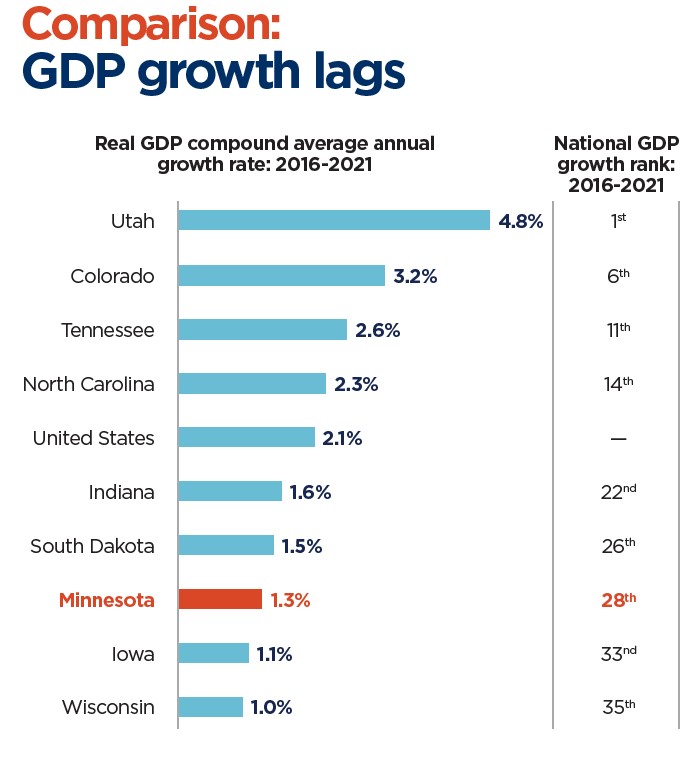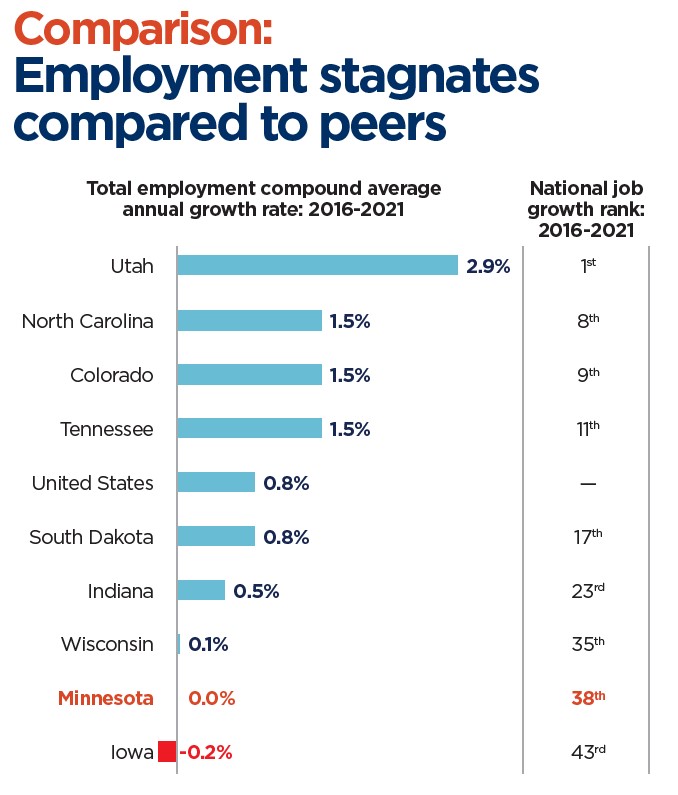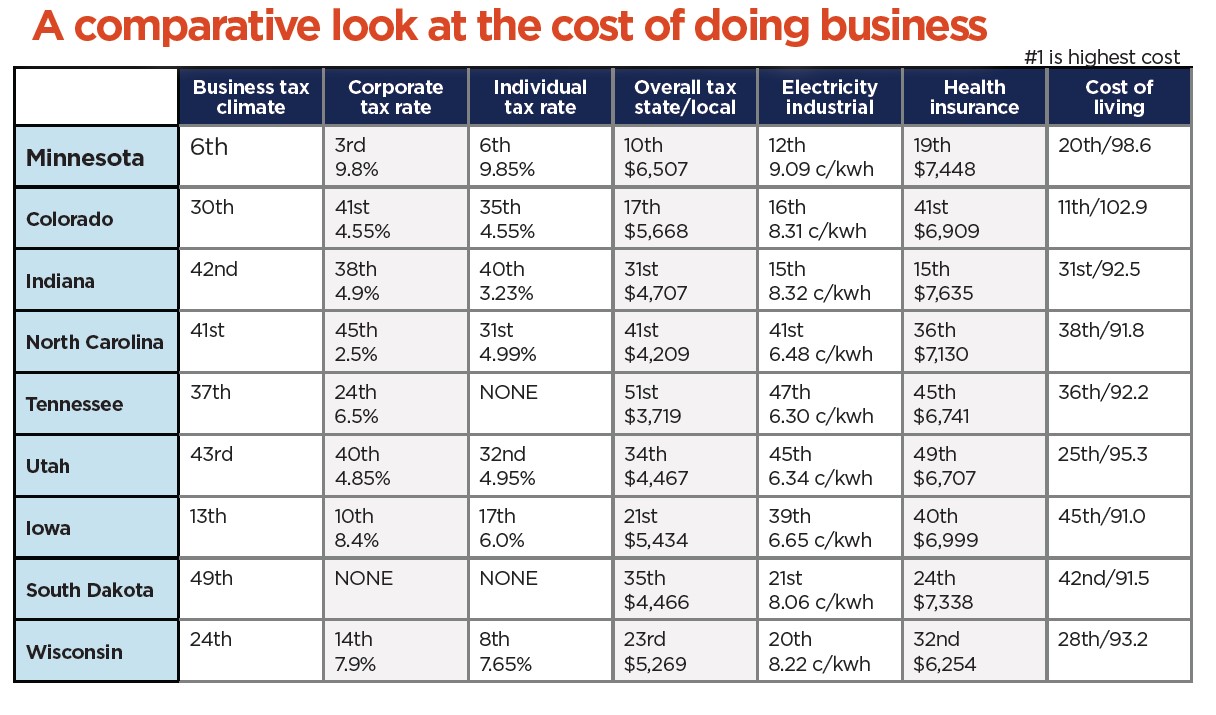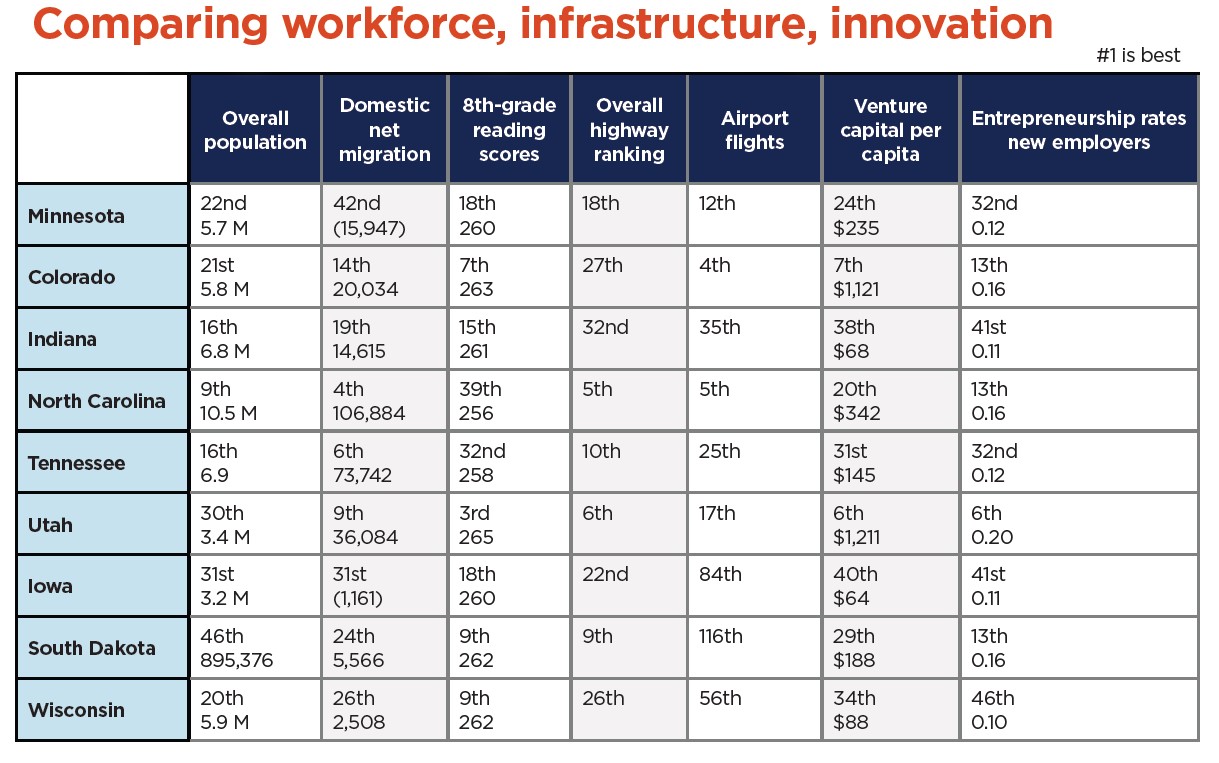2023 Business Benchmarks: What can Minnesota learn from other states?
Acknowledging a legacy of economic strength
Minnesota’s ranking on segments of the economy defines the state’s relative strength. As previously stated, there are undeniable strengths of Minnesota’s highly developed economy. The diverse base of industries, hardworking and educated workforce, industry leading companies, in addition to high innovation rates and abundant natural resources and cultural amenities. But the elements of our economy don’t exist on their own - whether they give us a competitive advantage is dependent on the actions of other states as well.
Many affectionately reference the “Minnesota Miracle” to remember a time when Minnesota was outperforming other states: the development of the computer industry fueled above average-economic growth, and personal incomes were significantly increasing. According to the Minnesota Chamber Foundation’s report Minnesota 2030: A framework for growth, the state continued that position of strength by outperforming the United States for more than three decades. State job growth exceeded the nation’s for 27 out of those 35 years, and incomes grew alongside until reaching a peak in 2004. It was, without question, an important period for our state’s economic growth.
But since 2005, Minnesota’s economy has grown more slowly than the U.S., averaging just 1.4% real GDP growth and 0.7% job growth, compared to 1.8% and 1.2%, respectively, for the U.S.
Understanding the state’s competitive strengths and weaknesses can determine what is needed to regain our competitive edge. States with either high-performing economies or that share regional traits can help understand where Minnesota can improve. In this report, comparison states include Colorado, Indiana, North Carolina, Tennessee and Utah (Utah has a smaller GDP and population but is a benchmark of top-performing growth). Neighboring states include Wisconsin, South Dakota and Iowa (North Dakota was excluded due to the volatile nature of the oil industry).

Economy and business climate
When it comes to overall economic performance, regional dynamics play a prominent role, with states in the Sunbelt and west experiencing more robust growth than Midwest states. Minnesota, Iowa and Wisconsin follow that trend, and consistently lag in the state rankings. But Indiana and South Dakota, each with low tax rates, are slightly above average, showing that Midwest states can outperform regional peers and join the top half of states in major indicators. South Dakota actually increased its GDP and population post-pandemic.

Of the comparison states in this report, Colorado, Tennessee, North Carolina and Utah are in the top tier for economic growth. Tennessee’s GDP growth is most impressive, jumping 9% in one year between 2020 and 2021, the most growth experienced in two decades.

Taxes and costs
There is a clear delineation between the economic performance of high-cost, high-tax states and its lower cost counterparts. Twenty-seven states have reformed their tax systems in the last two years, a step that makes them attractive to business investment, talent and growth. Twenty-five of those 27 states dropped their income or corporate tax rates, or both.
- Indiana, Utah and Colorado have both corporate and individual rates under 5%.
- South Dakota has no corporate or individual tax rate.
- Tennessee doesn’t have an income tax, and their corporate tax rate is 6.5%, considerably lower than Minnesota’s 9.86%.
- Iowa recently lowered their individual income tax rate to a flat 3.9% and slashed their corporate rate from 9.8% to 5.5% (with phase-in and triggers).
Other costs make a difference too, with industrial electric costs higher in Minnesota than in all of the comparison states in this report - Colorado, Indiana, North Carolina, Tennessee, Utah, Iowa, South Dakota and Wisconsin. Each of those states also have lower health care premiums than Minnesota for single coverage, with the exception of Indiana.

Innovation
The strength of private-sector innovation in Minnesota has long-driven its economic growth. But other states are showing their relative strength and surpassing Minnesota in many categories. Colorado and Utah are in the top 10 for venture capital per capita, with Colorado at $1,121 and Utah at $1,211. That’s nearly five times more than Minnesota’s $235 per capita.
South Dakota, North Carolina, Colorado and Utah’s new entrepreneurship rates are in the top 15 of the nation.

Infrastructure
Higher taxes and costs don’t necessarily translate to better infrastructure outcomes. Four of the comparison states in this report rank better in highway performance than Minnesota: North Carolina, Tennessee, Utah and South Dakota. These other states also have strong broadband infrastructure and large airports for the flow of goods and commerce. Even though Minnesota has a major international airport, ranking 12th best in the nation, North Carolina and Colorado have more flights than Minnesota.
Workforce
A strong and talented workforce is a key ingredient of any state’s success. As previously discussed, Minnesota has grown its population over the past five years, but this is principally from international immigration and struggles to bring workers from other states.
In 2021, Minnesota actually lost 15,947 workers to other states. By comparison, North Carolina, Tennessee, Utah and Colorado were among the top 15 states for domestic migration. Colorado has a low jobless rate and high labor participation, similar to Minnesota. But they’ve also experienced sharp gains in employment, specifically in leisure and hospitality, professional and business services.
One way to build a workforce is attracting workers from other states; another is to build a long-term talent pipeline at home. Most states are struggling with a post-pandemic downward trend in test scores among their students. Regionally, Wisconsin and South Dakota have better 8th-grade reading scores than Minnesota (tied for 9th best in the nation, compared to Minnesota at 18th). Students in Colorado and Utah scored high in both 8th- and 4th-grade reading, scoring near the top of the nation, compared to Minnesota, which ranks 28th.

Takeaways for Minnesota
Lagging other states in economic growth rates may not be a significant concern for Minnesota in the short-term (so long as absolute levels are high). But slow growth over time can erode the state’s relative advantage and may not maintain the strength of our economy, in the future as we have achieved over the past few decades. A strong and growing economy requires a strong and growing private sector. Fewer opportunities for private sector growth can erode the high quality of life. Minnesota should address policies creating a roadblock to private sector growth and undermining investment, entrepreneurship, talent recruitment and retention.

Navigating the 2023 Business Benchmarks report
Questions about the 2023 Business Benchmarks report?
We'd love to hear from you! If you have questions on this year's Business Benchmarks or would like to get involved on the topics listed above, please contact us or reach out to one of our expert staff.




